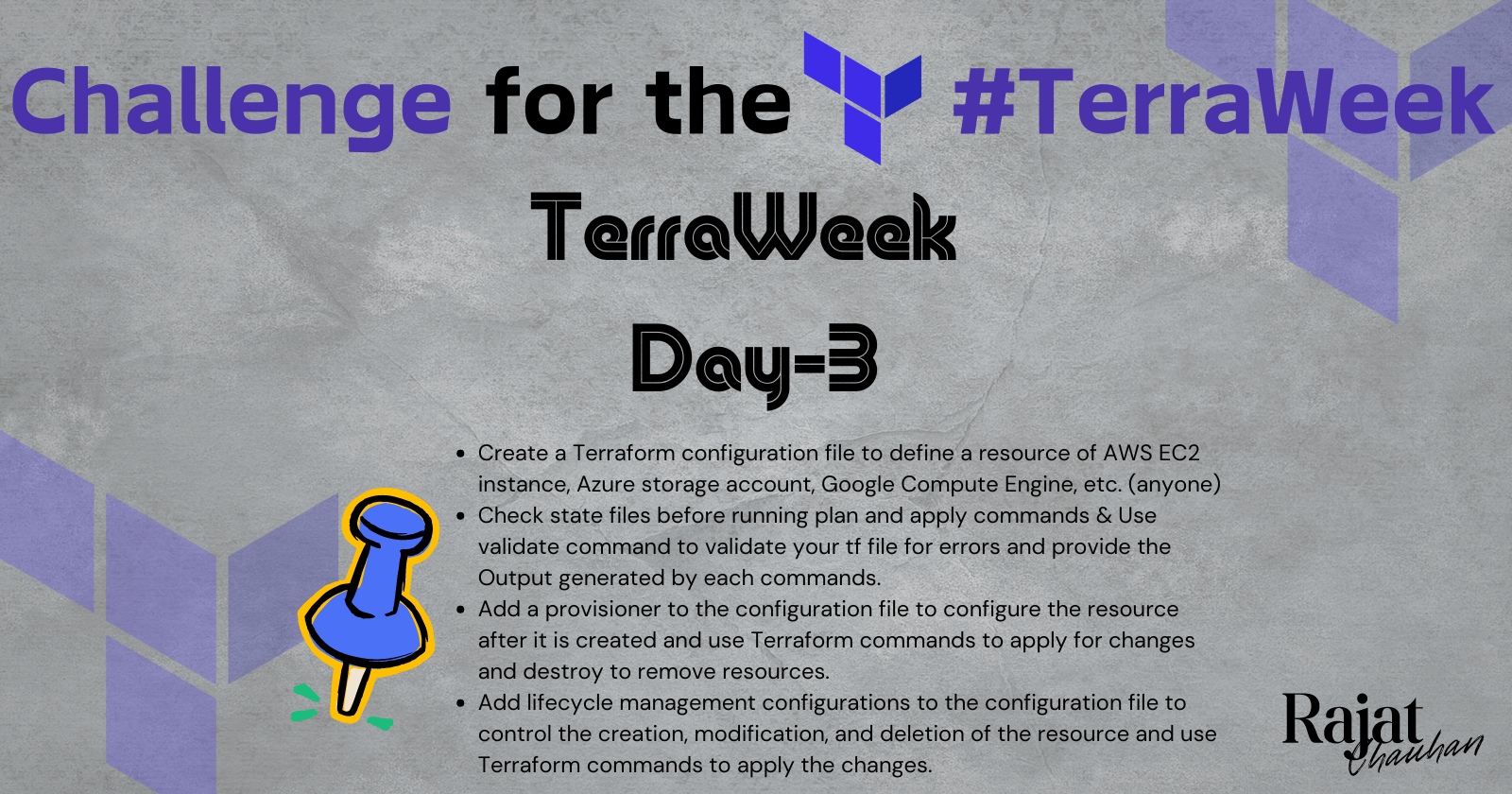Mastering Terraform with AWS EC2
 Rajat Chauhan
Rajat Chauhan
On Day 3 of TerraWeek, we delve into the practical use of Terraform to manage infrastructure as code. Today’s focus is on creating and managing resources like AWS EC2 instances, Azure storage accounts, or Google Compute Engine resources using Terraform. We’ll cover writing configuration files, validating them, and using provisioners and lifecycle management configurations.
Task 1: Create a Terraform Configuration File
For this example, we'll create an AWS EC2 instance. Start by defining the resource in a .tf file.
Example main.tf:
provider "aws" {
region = "us-west-2"
}
resource "aws_instance" "example" {
ami = "ami-0c55b159cbfafe1f0"
instance_type = "t2.micro"
tags = {
Name = "TerraWeek-EC2"
}
}
This configuration sets up an AWS EC2 instance in the us-west-2 region using a specific Amazon Machine Image (AMI) and tags the instance with the name "TerraWeek-EC2."
Task 2: Check State Files and Validate Configuration
Before running the plan and apply commands, it’s essential to check the state files and validate the configuration.
Check State Files:
To inspect state files, you can use:
terraform state list
This command lists the resources currently managed by Terraform in your state file.
Validate Configuration:
Use the validate command to check your configuration file for syntax errors.
terraform validate
Expected Output:
If everything is correct, you should see:
Success! The configuration is valid.
Now, you can proceed with the plan and apply commands:
terraform plan
terraform apply
Task 3: Add a Provisioner
Provisioners in Terraform execute scripts on a local or remote machine as part of resource creation or destruction. Here, we’ll add a simple file provisioner to copy a file to the EC2 instance.
Updated main.tf:
resource "aws_instance" "example" {
ami = "ami-0c55b159cbfafe1f0"
instance_type = "t2.micro"
tags = {
Name = "TerraWeek-EC2"
}
provisioner "file" {
source = "script.sh"
destination = "/tmp/script.sh"
}
provisioner "remote-exec" {
inline = [
"chmod +x /tmp/script.sh",
"/tmp/script.sh"
]
}
}
Apply the Changes:
After adding the provisioner, run:
terraform apply
Destroy the Resources:
To remove the resources:
terraform destroy
Task 4: Lifecycle Management
Terraform’s lifecycle management lets you control when and how resources are created, updated, or destroyed. We’ll add lifecycle rules to prevent the EC2 instance from being accidentally killed.
Updated main.tf:
resource "aws_instance" "example" {
ami = "ami-0c55b159cbfafe1f0"
instance_type = "t2.micro"
tags = {
Name = "TerraWeek-EC2"
}
lifecycle {
prevent_destroy = true
}
provisioner "file" {
source = "script.sh"
destination = "/tmp/script.sh"
}
provisioner "remote-exec" {
inline = [
"chmod +x /tmp/script.sh",
"/tmp/script.sh"
]
}
}
Apply Lifecycle Changes:
Run:
terraform apply
Testing Lifecycle Configuration:
Attempting to destroy the resource should now trigger a warning due to the prevent_destroy lifecycle setting:
terraform destroy
Expected Output:
Error: Instance cannot be destroyed
This prevents accidental destruction of critical infrastructure.
Thank you for taking the time to read! 💚
Subscribe to my newsletter
Read articles from Rajat Chauhan directly inside your inbox. Subscribe to the newsletter, and don't miss out.
Written by

Rajat Chauhan
Rajat Chauhan
Rajat Chauhan is a skilled Devops Engineer, having experience in automating, configuring, deploying releasing and monitoring the applications on cloud environment. • Good experience in areas of DevOps, CI/CD Pipeline, Build and Release management, Hashicorp Terraform, Containerization, AWS, and Linux/Unix Administration. • As a DevOps Engineer, my objective is to strengthen the company’s applications and system features, configure servers and maintain networks to reinforce the company’s technical performance. • Ensure that environment is performing at its optimum level, manage system backups and provide infrastructure support. • Experience working on various DevOps technologies/ tools like GIT, GitHub Actions, Gitlab, Terraform, Ansible, Docker, Kubernetes, Helm, Jenkins, Prometheus and Grafana, and AWS EKS, DevOps, Jenkins. • Positive attitude, strong work ethic, and ability to work in a highly collaborative team environment. • Self-starter, Fast learner, and a Team player with strong interpersonal skills • Developed shell scripts (Bash) for automating day-to-day maintenance tasks on top of that have good python scripting skills. • Proficient in communication and project management with good experience in resolving issues.